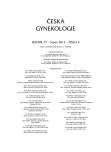Acute or expectant management in premature labour with preterm premature rupture of the membranes?
Authors:
Z. Hájek 1; V. Horáková 1; M. Koucký 1; M. Dokoupilová 2; R. Plavka 1; A. Pařízek 1
Authors‘ workplace:
Gynekologicko-porodnická klinika 1. LF UK a VFN Praha, přednosta prof. MUDr. A. Martan, DrSc.
1; Neonatologické oddělení nemocnice Hořovice, vedoucí MUDr. M. Dokoupilová
2
Published in:
Ceska Gynekol 2012; 77(4): 341-346
Overview
Objective:
To evaluate current knowledge about the management of preterm premature rupture of the membranes (PPROM).
Design:
Review article.
Setting:
Perinatological center, Department of Gynecology and Obstetrics, General Faculty Hospital and 1st Medical School of Charles University, Prague.
Methods and results:
Expectant management in case of PPROM increases the incidence of infection/ inflammation but does not statistically increase mortality and serious morbidity of the infants. The incidence of infants morbidity corresponds with gestational age. The most serious complications occur in the lower gestational age. It is necessary to take an individual approach. The acute management increases the number of operative deliveries and respiratory distress syndrome (RDS) in the infants. The combination of RDS, extremely prematurity and hypoxia during the labour decreases the infants survival rate.
Conclusions:
The prolongation of the latency period in pregnancies above 28th week does not deteriorate the neonatal mortality or morbidity.
Key words:
premature labour, premature rupture of the membranes.
Sources
1. Berger, TM., Bernet, V., El Alama, S., et al. Perinatal care at the limit of viability between 22 and 26 completed weeks of gestation in Switzerland. Swiss Medical Weekly, 2011, 141, p. 2–13.
2. Cudin, MH., Van Schalkwyk, J., VanEyk, N., et al. Antibiotic therapy in preterm premature rupture of the membranes. J Obstet Gynecol Can, 2009, 31, p. 863–867.
3. Caughey, AB., Robinson, JN., Norwitz, ER, Contemporary diagnosis and management of preterm premature rupture of membranes. Rev Obstet Gynecol, 2008, 1, p. 11–22.
4. Daskalakis, DJ., Papantoniu, NE., Koutsodimes, NB. Fetal fibronectin as a predictor of preterm birth. J Obstet Gynaecol, 2000, 20, p. 347–353.
5. Donohue Pamela, K., Boss, RD., Shepard, J. Intervention at the border of viability. Arch Pediatr adolesc Med, 2009, 163, p. 902–906.
6. Falk, SJ., Ambell, LJ., Lee-Parritz, A., et al. Expectant management in spontaneous preterm premature rupture of membranes between 14–24 weeks gestation. J Perinat Med, 2004, 24, p. 611–616.
7. Hajek, Z., Germanova, A., Koucky, M., et al. Detection of feto-maternal infection/inflammation by the soluble receptor for advanced glycation end products (sRAGE): results of a pilot study. J Perinat Med, 2008, 36, p. 399–404.
8. Kayem, G., Bernier-Duprelle, A., Coffinet, F., et al. Active versus expectant management for preterm prelabour rupture of membranes at 34–36 weeks of completed gestation: comparison of maternal and neonatal outcomes. Acta Obstet Gynecol Scand, 2010, 89, p. 776–781.
9. Kayem, H., Maillard, F., Schmitz, L., et al. Prediction of clinical infection in women with preterm labour with intact membranes: a score based on ultrasonographic, clinical and biological markers. Eur J Obstet Gynecol Reprod Biol, 2009, 145, p. 36–40.
10. Medina, TM., Ashley Hill, D. Preterm premature rupture of membranes: Diagnosis,management. Amer Family Physic, 2006, 15, p. 659–664.
11. Mercer, MB. Is there a role for tocolytic therapy during conservative management of preterm premature rupture of the membranes? Clin Obstet Gynecol, 2007, 50, p. 487–496.
12. Mercer, MB. Preterm premature rupture of the membranes. Obstet Gynec, 2003, 101, p. 179–193.
13. Mercer, MB., Goldenberg, RL., Moawad, AH., et al. The preterm prediction study: Effect of gestational age and cause of preterm birth on subsequent obstetric outcome. Am J Obstet Gynecol, 1999, 181, p. 1216–1221.
14. Naef, RW., Albert, JR., Ross, EL., et al. Premature rupture of membranes at 34–37 weekęs gestation: aggresive versus conservative management. Am J Obstet Gynecol, 1998, 178, p. 126–130.
15. Park, CW., Lee, SM, Park, JK., et al. The antenatal identification of funisitis with rapid MMP-8 bedside test. J Perinat Med, 2008, 36, p. 496–502.
16. Poma, PA. Premature rupture of membranes. J Natl Med Assoc, 1996, 88, p. 27–32.
17. Ramsey, PS., Nuthalapaly, FS., Ramin, S., et al. Contemporary management of preterm premature rupture of membranes (PPROM): a servey of maternal-fetal medicine providers. Am J Obstet Gynecol, 2004, 191, p. 1497–1502.
18. Romero, R., Espinato, J., Hassan, S., et al. The use of high-dimensional biology (genomics, trascriptomics, proteomics and metabolomics) to understand the preterm parturition syndrome. BJOG, 2006, 113, p. 118–135.
19. Rahkonen, L., Rutanen, EM., Nuutila, M. Elevated levels of decidual insulin-like growth factor binding protein-1 in cervical fluid in early and mid-pregnancy are associated with an increased risk of spontaneous preterm delivery BJOG 2010, 117, p. 701–771.
20. Spinnato, JA., Shaver, DC., Bray, EM., et al. Preterm premature rupture of the membranes with fetal pulmonary maturity present: a prospective study. Obstet Gynecol, 1987, 69, p. 96–201.
21. Sorokin, Y., Romero, R., Mele, L., et al. Maternal serum interleukin-6, CRP and MMP-9 concentrations as a risk factor for preterm birth <32 weeks and adverse neonatal outcomes. Am J Perinatol, 2010, 27, p. 631–640.
22. Sunagawa, S., Takagui, K., Ono, K. Comparison of biochemical markers and cervical lenght for predicting preterm delivery. J Obstet Gynecol Res, 2008, 34, p. 812–819.
23. Tita, ATN., Andrews, WW. Diagnosis and management of clinical chorioamnionitis. Clin Perinatol, 2010, 37, p. 339–354.
24. Vande Ham, DP., Nimbus, JG., Mol, BW., et al. Induction of labor versus expectant management in women with preterm prelabor rupture of membranes between 34 and 37 weeks (The PPROMEXIL-trial). BMC, Pregnancy and Childbirth, 2007, 7, p. 11–16.
25. Vidaeff, AC., Ramin, SM. Antenatal corticosteroids after preterm premature rupture of membranes. Clin Obstet Gynecol, 2011, 54, p. 337–343.
Labels
Paediatric gynaecology Gynaecology and obstetrics Reproduction medicineArticle was published in
Czech Gynaecology

2012 Issue 4
Most read in this issue
- Endometriosis
- Vaginal prolapse and levator ani avulsion injury
- The rational preoperative diagnosis of ovarian tumors – imaging techniques and tumor biomarkers (review)
- Ultrasound in urogynecology
